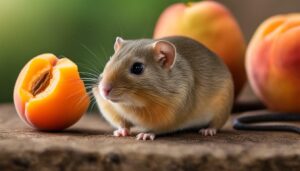Greetings, fellow nature enthusiasts! Today, we embark on a fascinating journey to explore the visual world of groundhogs.
Have you ever wondered if these furry creatures are colorblind? Join us as we delve into their vision, perception, and abilities to uncover the truth.
Groundhogs, also known as woodchucks, are renowned for their burrowing prowess and their ability to predict the arrival of spring.
But when it comes to their visual capabilities, are they able to perceive the vibrant colors that surround them? Let’s find out.
Contrary to popular belief, groundhogs are not colorblind. As they mature, their eyesight becomes sharp and clear, allowing them to see their surroundings with relative precision. However, their visual acuity is more attuned to dark colors, and their color vision is not as well-developed as in other animals. While they can recognize dark colors, their perception of specific colors is limited.
Key Takeaways:
- Groundhogs are not blind and have good eyesight when mature.
- They can recognize dark colors but do not have full color vision.
- Groundhogs have a preference for dark colors.
- Their color vision is not as advanced as in other animals.
- Groundhogs primarily rely on their senses to navigate their surroundings.
Do Groundhogs Have Color Vision?
Groundhogs, also known as woodchucks, possess a fascinating ability to see and differentiate between colors to some extent.
While their color vision is not as developed as in other animals, they are not completely colorblind.
Research suggests that groundhogs may even have favorite colors, showing a preference for dark colors over bright ones.
Despite their limited color perception, groundhogs primarily observe the darkness or light performance of different colors, rather than distinguishing specific hues.
Their visual perception focuses more on the contrast between light and dark, rather than the nuances of various shades.
As diurnal animals, groundhogs rely on their visual acuity to navigate their surroundings and detect potential threats.
While their color vision may not be as detailed as some other animals’, groundhogs’ ability to perceive and differentiate between colors contributes to their overall sensory perception.
It aids them in identifying objects and distinguishing patterns in their environment. By combining their visual perception with their other senses, such as their acute sense of hearing and smell, groundhogs are well-equipped to thrive in their natural habitat.
Groundhog Eyesight: Can Groundhogs See Colors?

When it comes to groundhog eyesight, these furry creatures have relatively good vision. They are able to see objects from a distance of 250 to 300 yards, allowing them to effectively spot potential threats or sources of food.
However, their color vision is not as advanced as that of some other animals. While groundhogs can perceive colors to some extent, their ability to distinguish between specific colors is limited.
Research indicates that groundhogs may have a preference for dark colors, such as dark blues and purples.
This suggests that they may be more attracted to objects or surroundings that exhibit these darker hues.
However, it’s important to note that their color perception is not as robust as in animals with more specialized color vision systems.
As diurnal animals, groundhogs are primarily active during the day. Their eyesight allows them to navigate their surroundings and detect potential threats while foraging for food.
However, their vision in low-light conditions, such as during dawn or dusk, is not as sharp.
Can Groundhogs See Colors?
- Groundhogs have relatively good eyesight, enabling them to see objects from a distance of 250 to 300 yards.
- They can perceive colors to some extent, although their color vision is not as advanced as in other animals.
- Researchers suggest that groundhogs may be more attracted to dark colors, such as dark blues and purples.
- However, their color perception is not as specialized or nuanced as in animals with more developed color vision systems.
Can Groundhogs See in the Dark?

Contrary to popular belief, groundhogs do not have good night vision. They are diurnal animals, meaning they are primarily active during the day.
While they may emerge from their burrows in the early morning or at night, it is not because they can see well in the dark.
Groundhogs have poor night vision and rely more on their other senses to navigate in low-light conditions.
Groundhogs have adapted to their diurnal lifestyle, with their eyesight being optimized for daytime activities.
Their eyes contain a higher concentration of rod cells, which are responsible for vision in dim light. However
Groundhog Night Vision: A Closer Look
Groundhogs have a limited number of cone cells, the photoreceptor cells responsible for color vision.
This deficiency makes it difficult for them to see in low-light conditions, including the dark.
Instead, they rely on their heightened sense of hearing and their excellent sense of smell to navigate their surroundings when the light is dim.
- While groundhogs may emerge from their burrows during twilight or nighttime, it is usually for specific reasons such as feeding or searching for mates. Their primary goal during these outings is not to rely on their vision, but rather to utilize their other senses to detect potential threats or opportunities.
. - By relying on their sense of hearing, groundhogs can listen for any signs of danger that may be lurking in the darkness. This acute sense of hearing provides them with an early warning system, allowing them to quickly retreat to their burrows if necessary.
. - In addition to their keen hearing, groundhogs possess a highly developed sense of smell. This allows them to detect the presence of predators, locate sources of food, and differentiate between various scents in their environment.
Although groundhogs may not have the ability to see well in the dark, their adaptations in hearing and smell compensate for their limited night vision.
These adaptations help them survive and thrive in their natural habitats, despite the challenges they may face in low-light conditions.
Groundhog Hearing and Sense of Smell

Groundhogs possess remarkable sensory abilities that help them navigate their environment and ensure their survival. One of their notable senses is hearing.
Groundhogs have a keen sense of hearing, allowing them to detect approaching danger from a distance.
This heightened auditory perception gives them valuable time to locate a safe place to hide from potential threats.
In addition to their acute hearing, groundhogs also rely on their sense of smell. This olfactory prowess aids them in multiple ways.
Groundhogs can detect the presence of predators through their sharp sense of smell, enabling them to take defensive measures promptly.
Furthermore, their sense of smell plays a crucial role in finding food. Groundhogs can detect and locate sources of food by following scent trails, ensuring they have a steady supply of sustenance.
Notably, groundhogs can even differentiate between different animals’ urine smells. This ability allows them to determine whether an approaching animal is a potential threat or a harmless neighbor.
By discerning these olfactory cues, groundhogs can make informed decisions to ensure their safety and well-being.
Overall, the combination of groundhog hearing and sense of smell enhances their survival instincts and enables them to thrive in their natural habitat.
Conclusion
In conclusion, groundhogs possess impressive sensory abilities that allow them to thrive in their natural habitats.
These abilities include good eyesight, hearing, and sense of smell. Although groundhogs are not colorblind, their color perception is not as developed as in other animals.
They can perceive and differentiate between colors to some extent, but their focus lies more on the darkness or light performance of different colors rather than specific hues.
Groundhogs heavily rely on their senses to navigate their surroundings, detect potential threats, and locate food sources.
Their good eyesight enables them to spot objects from a distance, while their keen sense of hearing alerts them to approaching danger.
Additionally, their acute sense of smell helps them identify predators and distinguish between friends and foes.
While groundhogs may not possess the same level of color vision as humans or some other animals, their sensory abilities allow them to adapt and survive in their environments effectively.
By utilizing their senses, groundhogs can make accurate assessments of their surroundings, allowing them to respond appropriately to various situations.
Overall, groundhogs’ sensory repertoire, including their visual perception, plays a crucial role in their everyday lives and contributes to their ability to thrive as remarkable creatures.
Frequently Asked Questions
Q: Do groundhogs have good night vision?
A: Groundhogs have relatively poor night vision. They are primarily diurnal, meaning they are active during the day, and their eyes are better adapted to daylight conditions rather than the dark of night.
Q: Are groundhogs colorblind at night?
A: Like many mammals, groundhogs have limited color vision and are likely more colorblind at night. Their night vision is not as developed as some nocturnal animals, making it harder for them to discern colors in low-light conditions.
Q: Are groundhogs colorblind at night in the winter?
A: Groundhogs’ color vision capabilities do not change seasonally, so they would be equally colorblind at night in the winter as at other times. However, groundhogs hibernate in winter and are less active during this period.
Q: Can groundhogs see in the dark?
A: Groundhogs have limited ability to see in the dark. They are not adapted for night vision like some nocturnal animals. Groundhogs rely more on their senses of hearing and smell in darker conditions.
Q: What senses do groundhogs rely on?
A: Groundhogs rely heavily on their senses of hearing and smell to detect predators and navigate their environment. While they do have vision, it is better suited for daylight hours and is not their primary sense for detecting danger or foraging.




